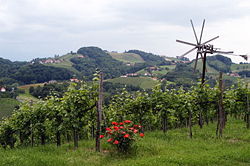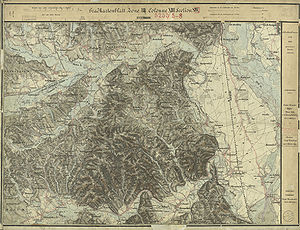
Sausal
Encyclopedia

Austria
Austria , officially the Republic of Austria , is a landlocked country of roughly 8.4 million people in Central Europe. It is bordered by the Czech Republic and Germany to the north, Slovakia and Hungary to the east, Slovenia and Italy to the south, and Switzerland and Liechtenstein to the...
's state Styria. It thrusts up from the northern banks of the Sulm valley, west of the district town of Leibnitz
Leibnitz
Leibnitz is a city in the Austrian state of Styria and at the 2001 census had a population of approximately 7.577 .It is located to the south of the city of Graz, between the Mur and Sulm rivers....
. Its highest point, the summit of the Demmerkogel, rises 671 m above the level of the Adriatic Sea. Large parts of the Sausal have a mediterranean-type microclimate
Microclimate
A microclimate is a local atmospheric zone where the climate differs from the surrounding area. The term may refer to areas as small as a few square feet or as large as many square miles...
. Together with the rich soil this is the basis of its extensive vineyard
Vineyard
A vineyard is a plantation of grape-bearing vines, grown mainly for winemaking, but also raisins, table grapes and non-alcoholic grape juice...
s, which are the cornerstone of the local economy. Tourism flourishes as well.

History

Urnfield culture
The Urnfield culture was a late Bronze Age culture of central Europe. The name comes from the custom of cremating the dead and placing their ashes in urns which were then buried in fields...
village, and much better preserved late neolithic
Neolithic
The Neolithic Age, Era, or Period, or New Stone Age, was a period in the development of human technology, beginning about 9500 BC in some parts of the Middle East, and later in other parts of the world. It is traditionally considered as the last part of the Stone Age...
construction traces below it. Archaeologists now associate this older Copper age
Copper Age
The Chalcolithic |stone]]") period or Copper Age, also known as the Eneolithic/Æneolithic , is a phase of the Bronze Age in which the addition of tin to copper to form bronze during smelting remained yet unknown by the metallurgists of the times...
settlement with the Lasinja
Lasinja
Lasinja is a municipality in Karlovac County, Croatia. There are 1,938 inhabitants, 88% of whom are Croats and 10.27% who are Serbs....
culture.
The name Sausal first appeared as Susil in 970, when emperor Otto I
Otto I, Holy Roman Emperor
Otto I the Great , son of Henry I the Fowler and Matilda of Ringelheim, was Duke of Saxony, King of Germany, King of Italy, and "the first of the Germans to be called the emperor of Italy" according to Arnulf of Milan...
assigned a strip of territory between the Sulm and the Laßnitz rivers to the Archbishop of Salzburg. This is supposed to be derived from Latin (silva Solva, i.e., the "forest at the Sulm river"). During these early medieval times the steep hills were completely forested, awash with deer and boar, and ideal for hunting.
The Bavaria
Bavaria
Bavaria, formally the Free State of Bavaria is a state of Germany, located in the southeast of Germany. With an area of , it is the largest state by area, forming almost 20% of the total land area of Germany...
n immigrants colonizing the area had found the mountain range almost uninhabited, as it perhaps had been throughout Roman times, only with small Slavic
South Slavs
The South Slavs are the southern branch of the Slavic peoples and speak South Slavic languages. Geographically, the South Slavs are native to the Balkan peninsula, the southern Pannonian Plain and the eastern Alps...
settlements scattered in its larger valleys. They immediately began to convert much of the dense forests to cultured land, and started to grow wine. By the 12th century, peasants routinely paid large parts of their taxes in various viniculture products. Salzburg nobility founded a number of estates (some of which exist even today) to exert some control over the wildlife and the hunting operations.
Local culture and economy
Forestry, hunting and wine culture essentially defined local life for the following centuries. This continued after 1595 when Salzburg's archbishop Wolf Dietrich gave the town of LeibnitzLeibnitz
Leibnitz is a city in the Austrian state of Styria and at the 2001 census had a population of approximately 7.577 .It is located to the south of the city of Graz, between the Mur and Sulm rivers....
and the eastern part of the Sausal mountain range to the bishop of Seckau. Wine culture peaked in the 17th century and slowly retreated until the late 20th century. Today, only the municipalities of Kitzeck and St. Andrä-Höch rely mainly on wine. Most recently however, several new vineyards have been planted on the southern and western slopes of the Sausal.
A local peculiarity (though also found in other wine-growing areas of the region) is the Klapotez
Klopotec
A klopotec is a wooden mechanical device on a high wooden pole, similar to a windmill. It is used as a bird scarer in the vineyards of traditional wine-growing landscapes of Slovenia, Austria and Croatia...
, a traditional wooden contraption which remotely resembles a windmill from the North American plains, and is intended to scare birds away.
The local microclimate, with winter frosts relatively rare and mild, allows figs
Common fig
The Common fig is a deciduous tree growing to heights of up to 6 m in the genus Ficus from the family Moraceae known as Common fig tree. It is a temperate species native to the Middle East.-Description:...
and sometimes even kiwifruit
Kiwifruit
The kiwifruit, often shortened to kiwi in many parts of the world, is the edible berry of a cultivar group of the woody vine Actinidia deliciosa and hybrids between this and other species in the genus Actinidia....
to ripen in particularly protected places. The sweet chestnut
Sweet Chestnut
Castanea sativa is a species of the flowering plant family Fagaceae, the tree and its edible seeds are referred to by several common names such Sweet Chestnut or Marron. Originally native to southeastern Europe and Asia Minor, it is now widely dispersed throughout Europe and parts of Asia, such as...
, a warmth-adapted tree, grows abundantly in the wild.
Recently, the hillsides have become an attractive residential area for the more affluent strata of society in Styria's southern parts. Weekend domiciles also proliferate, not always in perfect harmony with the landscape.
Saint Theresa's Chapel
The Theresienkapelle, a large chapel built in 1834 and named after St. Teresa of ÁvilaTeresa of Ávila
Saint Teresa of Ávila, also called Saint Teresa of Jesus, baptized as Teresa Sánchez de Cepeda y Ahumada, was a prominent Spanish mystic, Roman Catholic saint, Carmelite nun, and writer of the Counter Reformation, and theologian of contemplative life through mental prayer...
(although it is dedicated to the Virgin Mary) is located on one of the most prominent summits in the steeper Southern part the Sausal mountain range. From its exposed site it offers an impressive panoramic view across the upper Sulm valley. On occasion of its total refurbishment in 2002 the chapel was adorned with a fresco
Fresco
Fresco is any of several related mural painting types, executed on plaster on walls or ceilings. The word fresco comes from the Greek word affresca which derives from the Latin word for "fresh". Frescoes first developed in the ancient world and continued to be popular through the Renaissance...
by Franziska Ceski von Ferrari depicting Virgin Mary as the mother of Jesus sitting in a vineyard, with St. Catherine of Siena
Catherine of Siena
Saint Catherine of Siena, T.O.S.D, was a tertiary of the Dominican Order, and a Scholastic philosopher and theologian. She also worked to bring the papacy of Gregory XI back to Rome from its displacement in France, and to establish peace among the Italian city-states. She was proclaimed a Doctor...
to her right and St. Thérèse of Lisieux to her left.
Villages in the Sausal mountains
The wine-growing village KitzeckKitzeck im Sausal
Kitzeck is the central settlement in the Sausal mountain range in Southern Styria, Austria. It is the highest-altitude wine-growing community in Central Europe. Kitzeck is home to the first wine museum that was established in Styria...
, which is uniquely situated high upon the hills and on clear days offers a beautiful vista far into the countryside, is a particularly popular tourist site. Its top-class restaurants and taverns are favorite meeting locations for business people and politicians.
Other notable places include:
- St. Nikolai im Sausal
- Sankt Andrä im Sausal

